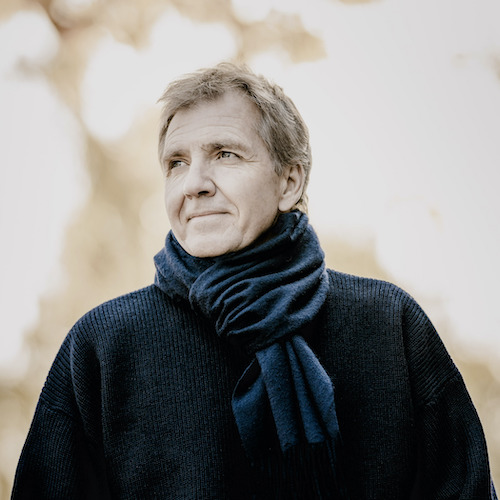Utah Symphony shines with Sibelius and tunes up for a Messiaen field trip

After drawing a near-capacity crowd for its last concert – Steven Osborne playing Rachmaninoff’s Second Piano Concerto – the Utah Symphony returned Friday to a less than half-filled Abravanel Hall for a concerto-less program of Smetana, Messiaen and Sibelius. Still, the musicians didn’t seem to mind the empty seats, and they turned in a gem of a concert.
Opening with Bedřich Smetana’s melodious tone poem, “The Moldau,” the concert showcased the orchestra’s musicality and its full, transparent sound under the baton of music director Thierry Fischer. “The Moldau” is the most popular movement of Smetana’s Czech-themed orchestral suite, Ma Vlast (“My Country”). It starts with a nimble flute solo in triplets punctuated by pizzicato strings, followed by a brief flute duet, before unwinding into the piece’s famous melody in the strings. Associate principal flutist Lisa Byrnes played the solo line with a charming lilt and engaging phrasing. Fisher seamlessly transferred the energy Byrnes built to the strings, which shimmered through the infectious main theme.
Fischer’s phrasing shaped the melody and gave it a sense of motion as it built to the climax. The sweeping, cinematic sound of the main theme contrasted with more subtle, witty development section, which Fischer conducted with pronounced staccato cut-offs and nimble runs. He reveled in the orchestra’s sound in the piece’s more atmospheric passages, before charging ahead in the more cadential recapitulation of the main theme, to which he gave a strong, celebratory energy.
“The Moldau’s” infectious melodies sharply contrasted with the chromaticism of the next pieces on the program: “La Grive des bois” and “Omao, Leiothrix, Elepaio, Shama”, the tenth and eleventh movements of Olivier Messiaen’s twelve-movement work Des Canyons aux etoiles … (“From the Canyons to the Stars … ”), which was inspired by the composer’s 1972 visit to Southern Utah, with two movements named after Bryce Canyon and Zion National Park. The Utah Symphony will travel to Zion and play the work in its entirety at an outdoor concert on June 2 and will preview two more movements from it at next weekend’s concert.
The relatively short selections – five and nine minutes respectively – required the stage crew to re-set the stage to accommodate a chamber orchestra around a piano. While the stage crew worked, ads for the orchestra’s next season and next month’s Zion concert played on a screen that descended from the ceiling.
“La Grive des bois” (“Wood Thrushes”) is based on Messiaen’s transcription of the song of the American Wood Thrush. It begins with an arpeggiated C Major chord – a C down to a G up to an E then back to a C – played by the flute and trumpet. This is followed by measure-long solos on wind machine, wood block, and bells – with pauses in between — followed by chromatic flurries on the xylophone, glockenspiel, and piano. This series repeats a few times with some variation, adding thick, dense chords in the winds, longer piano and xylophone flurries, and interpolations of initial C Major call. The effect is mesmerizing and tends to sharpen the listener’s attention, much like listening intently to birdsong.
“Omao, Leiothrix, Elepaio, Shama” – an amalgam of four different bird songs in the thrush family – takes a similar approach, using the same instruments, but the initial bird call is less consonant, and the texture is busier. On both pieces, the most impressive action was from principal percussionist Keith Carrick on xylophone, and associate principal timpanist Eric Hopkins on glockenspiel, and principal keyboardist Jason Hardink on piano, playing the furious chromatic runs that imitated the sometimes chaotic chirps birds make in between iterations of their identifiable calls.
Fischer’s lucid interpretation of both movements gave space for the piece’s disparate elements. Yet while the Messiaen was impressive and interesting, it garnered only a tepid response from the audience, which warmed much more to the orchestra’s transcendent rendition of Jean Sibelius’s Symphony No. 2.
Fischer captured the Sibelius piece’s optimism as well as its drama and made its disparate melodies cohere into a grand musical vision. His Beethoven-ian interpretation of the first movement was a tour de force for the stings and brass, displaying both sections’ ability to shape a musical phrase and create a gorgeous, transparent sound.
With a timpani roll that handed off to a walking pizzicato line in the bass and celli, the second movement opened sounding an air of mysterious fatalism — and then turned rapturously moody with the arrival of the upper strings. Fischer took his time, giving the music room to breath and grow, and making the most of the movement’s big statements. He took care to illuminate its contrasting major key moments, letting sunlight into the movement’s somber spaces in a demonstration of his particular gift for phrasing strings.
The emotional sweep of the piece’s third and fourth movements is rarely equaled in the classical repertoire, and Fischer captured the its full spectrum while paying special attention to the gorgeous sonorities in the composer’s cadences in the winds and low brass. The orchestra’s sonic transparency served the piece well, allowing the listener to enjoy the counterpoint and open 5ths and 6ths as the piece built to its climactic finish, which did not disappoint. At the last restatement of the piece’s final theme, the low strings and brass delivered a deeply satisfying close, which the brought the audience to its feet for a sustained ovation.
The program repeats 7:30 p.m. Saturday, May 21at Abravanel Hall. usuo.org